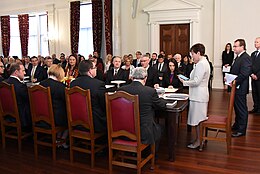This is an old revision of this page, as edited by 86.159.77.26 (talk) at 19:52, 9 June 2022 (Correct a link). The present address (URL) is a permanent link to this revision, which may differ significantly from the current revision.
Revision as of 19:52, 9 June 2022 by 86.159.77.26 (talk) (Correct a link)(diff) ← Previous revision | Latest revision (diff) | Newer revision → (diff) Central decision-making forum of the New Zealand Government
| Politics of New Zealand |
|---|
 |
| Constitution |
| The Crown |
| Executive Government |
|
Legislature54th New Zealand Parliament
|
| Elections |
Judiciary
|
| Local government |
|
Foreign relations
|
| Ideology |
| History |
| Related topics |
|
|
The Cabinet of New Zealand (Template:Lang-mi) is the New Zealand Government's body of senior ministers, accountable to the New Zealand Parliament. Cabinet meetings, chaired by the prime minister, occur once a week; in them, vital issues are discussed and government policy is formulated. Though not established by any statute, Cabinet has significant power in the New Zealand political system and nearly all bills proposed by Cabinet in Parliament are enacted.
The New Zealand Cabinet follows the traditions of the British cabinet system. Members of Cabinet are collectively responsible to Parliament for its actions and policies. Cabinet discussions are confidential and are not disclosed to the public apart from the announcement of decisions.
All ministers in Cabinet also serve as members of the Executive Council, the body tasked with advising the governor-general in the exercise of his or her formal constitutional functions. Outside Cabinet, there are a number of non-Cabinet ministers, responsible for a specific policy area and reporting directly to a senior Cabinet minister. Ministers outside Cabinet are also part of Cabinet committees and will regularly attend Cabinet meetings which concern their portfolios. Therefore, although operating outside of Cabinet directly, these ministers do not lack power and influence as they are still very much part of the decision making process.
Constitutional basis

Cabinet is not established by any statute or constitutional document but exists purely by long-established constitutional convention. This convention carries sufficient weight for many official declarations and regulations to refer to Cabinet, and a government department—the Department of the Prime Minister and Cabinet—is responsible for supporting it. Although Cabinet lacks any direct legislative framework for its existence, the Cabinet Manual has become the official document which governs its functions, and on which its convention rests.
The structure of Cabinet has as its basis the formal institution known as the Executive Council, the body tasked with advising the governor-general in the exercise of his or her formal constitutional functions (i.e. the "Governor-General in Council"). Most ministers hold membership of both bodies, but some executive councillors, known as "ministers outside Cabinet", are not ranked as Cabinet members and do not normally attend. The convention of a cabinet meeting separately from the Executive Council began during Edward Stafford's first tenure as premier (1856–1861). Stafford, a long-time advocate of responsible government in New Zealand, believed the colonial government should have full control over all its affairs, without the intervention of the governor. Because the governor chaired the Executive Council, Stafford intentionally met with his ministers without the governor present, thus reducing the Council to its formal role.
Powers and functions

The lack of formal legislation establishing Cabinet leaves the powers of its members only loosely defined. Cabinet generally directs and controls policy (releasing government policy statements), and is responsible to the House of Representatives (the elected component of Parliament). It also has significant influence over law-making, and all draft government bills must be submitted to the Cabinet Legislation Committee before they can be introduced to the House. Convention regarding Cabinet's authority has considerable force, and generally proves strong enough to bind its participants. Theoretically, each minister operates independently, having received a ministerial warrant over a certain field from the Crown. But the governor-general can dismiss a minister at any time, conventionally on the advice of the prime minister, so ministers are largely obliged to work within a certain framework.
Collective responsibility
Further information: Cabinet collective responsibilityCabinet itself acts as the accepted forum for establishing this framework. Ministers will jointly discuss the policy which the government as a whole will pursue, and ministers who do not exercise their respective powers in a manner compatible with Cabinet's decision risk losing those powers. This has become known as the doctrine of collective responsibility. Collective responsibility is a constitutional convention which rests on three principles. The first principle is unanimity, where members of Cabinet must publicly support decisions and defend them in public, regardless on any personal views on the matter. Secondly, the confidentiality limb means that all Cabinet discussions are to be kept confidential. This allows for open and explicit conversation, discussion and debate on the issues Cabinet chooses to look at. The final principle is confidence, where Cabinet and executive government must have the confidence of the House of Representatives. If there is no government, the governor-general has the ability to intervene to find a government that does have confidence.
Formally all ministers are equals and may not command or be commanded by a fellow minister. Constitutional practice does, however, dictate that the prime minister is primus inter pares, meaning 'first among equals'.
Problems arise when the prime minister breaches collective responsibility. Since ministerial appointments and dismissals are in practice in the hands of the prime minister, Cabinet can not directly initiate any action against a prime minister who openly disagrees with their government's policy. On the other hand, a prime minister who tries to act against concerted opposition from their Cabinet risks losing the confidence of their party colleagues. An example is former Prime Minister David Lange, who publicly spoke against a tax reform package which was sponsored by then-Finance Minister Roger Douglas and supported by Cabinet. Douglas was forced to resign, but when the Cabinet supported Douglas against Lange, the Prime Minister interpreted this as a vote of no-confidence in his leadership and stepped down.
Collective responsibility after MMP
The doctrine of collective responsibility has changed since the introduction of the mixed-member proportional system (MMP) in 1993 (see § Electoral reform). The change allowed for junior parties in a coalition the ability to 'agree to disagree' with the majority in order to manage policy differences. Following the 2011 general election the National-led government released the following statement in regards to the role of minor parties in the context of collective responsibility:
Collective responsibility applies differently in the case of support party Ministers. Support party Ministers are only bound by collective responsibility in relation to their own respective portfolios (including any specific delegated responsibilities). When support party Ministers speak about the issues in their portfolios, they speak for the government and as part of the government. When the government takes decisions within their portfolios, they must support those decisions, regardless of their personal views and whether or not they were at the meeting concerned. When support party Ministers speak about matters outside their portfolios, they may speak as political party leaders or members of Parliament rather than as Ministers, and do not necessarily support the government position.
Ministers outside Cabinet retain individual ministerial responsibility for the actions of their department (in common with Cabinet ministers).
Electoral reform and Cabinet structure
See also: Electoral reform in New ZealandThe 1993 electoral referendum in New Zealand resulted in a number of structural changes to Cabinet. The change to the MMP system ultimately led to a larger number of political parties in Parliament, as under the proportional representation system any political party can enter Parliament if they received five percent of the party vote or won one electorate seat. The increased representation resulted in the need to form coalitions between parties, as no single party received a majority of votes and seats under MMP until 2020.
In order to govern in a coalition under MMP, it is likely that a major party will have to relinquish and offer Cabinet positions to members of a minority party. The aftermath of the first MMP election in 1996 highlighted the changes resulting from the new proportional parliament. New Zealand First received 13.4% of the party vote, giving them 17 total seats in the House of Representatives (in contrast to 8.5% in the 1993 general election, conducted under the plurality voting system). This ultimately resulted in the National–New Zealand First coalition as the National Party, who received 33.8% of the party vote, translating to 44 seats in the House, could not govern alone.
Negotiations forming the new government took nearly two months however the ultimate result being that New Zealand First were to have five ministers inside Cabinet and four outside. This translated to having 36.4% of representation in the new government. The Prime Minister following the 1996 election, Jim Bolger, was forced to tell his caucus during negotiations with New Zealand First, that he would not be able to satisfy all ambitions of the caucus, due to the forced inclusion of the minority party into the governmental framework, thus highlighting one of the challenges that came with MMP.
The result of MMP on Cabinet structure in New Zealand is also highlighted below under the § Members heading. In the coalition deal following the election New Zealand First leader Winston Peters was given the position of deputy prime minister, and New Zealand First were given a number of ministerial portfolios including foreign affairs, infrastructure, regional economic development, and internal affairs.
Meetings

Members of Cabinet meet on a regular basis, usually weekly on a Monday, to discuss the most important issues of government policy. The meetings are chaired by the prime minister or, in the prime minister's absence, the next most senior minister in attendance, usually the deputy prime minister. Ministers outside Cabinet may occasionally be invited for the discussion of particular items with which they have been closely involved. All Cabinet meetings are held behind closed doors, and the minutes are taken by the Cabinet secretary and kept confidential. However, usually shortly after the weekly meeting the prime minister holds a press conference to discuss important national issues.
The Cabinet secretary and their deputy are the only non-ministers who attend Cabinet meetings. They are not political appointments and their role at Cabinet meetings is to formulate and record the Cabinet's decisions and advise on procedure, not to offer policy advice. The secretary has a dual role as the clerk of the Executive Council where they provide a channel of communication and liaison between the Cabinet and the governor-general.
The Cabinet room, where the weekly meetings are normally held, and related offices are located at the top of the Beehive (the Executive Wing of Parliament Buildings).
Members
See also: Ministers in the New Zealand GovernmentThe prime minister assigns roles to ministers and ranks them in order to determine seniority. A minister's rank depends on factors such as "their length of service, the importance of their portfolio and their personal standing with the prime minister". The deputy prime minister is the second-highest ranked, after the prime minister. Under MMP, there are three categories of minister: ministers within the 'core' Cabinet, ministers outside Cabinet, and ministers from support parties (i.e. minor parties which have agreed to support a government party during confidence and supply votes). The size of Cabinet has grown over time. In the 1890s, for example, there were seven Cabinet ministers. The number of ministers within Cabinet increased in the period up until the 1970s, but has plateaued at 20 since 1972; this despite increases in the number of members of parliament. By contrast, the numbers of ministers outside Cabinet has grown, especially since the introduction of MMP.
All ministers are formally styled "The Honourable" (abbreviated to "The Hon."), except for the prime minister who is accorded the style "The Right Honourable" ("The Rt. Hon."). Formerly some other senior ministers used "The Right Honourable" by virtue of membership of the Privy Council of the United Kingdom, but appointments were discontinued in 2000.
List of current ministers
Main article: Sixth Labour Government of New ZealandThe current Labour government has a Cabinet of 20 ministers. There are four Labour Party ministers outside Cabinet; and two support ministers from the Green Party, which has a 'cooperation agreement' with the Labour government. Additionally, there are two parliamentary under-secretaries who assist the ministers from a parliamentary standpoint.
The table below lists Cabinet ministers, ministers outside Cabinet, and parliamentary under-secretaries, sworn in on 6 November 2020.
| Labour | |
| Greens |
| Ranking | Portfolios | Image | Incumbent | Additional responsibilities | Electorate | |
|---|---|---|---|---|---|---|
| 1. | Prime Minister Minister for National Security and Intelligence Leader of the Labour Party |

|
Jacinda Ardern | Minister for Child Poverty Reduction Minister Responsible for Ministerial Services Associate Minister for Arts, Culture and Heritage |
Mt Albert | |
| 2. | Deputy Prime Minister Minister of Finance Minister for Infrastructure Minister for Racing Minister for Sport and Recreation |

|
Grant Robertson | Wellington Central | ||
| 3. | Minister for Māori Crown Relations: Te Arawhiti Minister for Children Minister of Corrections Deputy Leader of the Labour Party |

|
Kelvin Davis | Associate Minister of Education (Māori Education) | Te Tai Tokerau | |
| 4. | Minister of Housing Minister of Energy and Resources Minister of Research, Science and Innovation |

|
Megan Woods | Associate Minister of Finance | Wigram | |
| 5. | Minister for COVID-19 Response Minister of Education Minister for the Public Service |

|
Chris Hipkins | Leader of the House | Remutaka | |
| 6. | Minister for Social Development and Employment Minister for ACC Minister for Arts, Culture and Heritage Minister for Disability issues |

|
Carmel Sepuloni | Kelston | ||
| 7. | Minister of Health Minister Responsible for the GCSB Minister Responsible for the NZSIS Minister for Treaty of Waitangi Negotiations |

|
Andrew Little | Minister Responsible for Pike River Re-entry Lead Coordination Minister for the Government’s Response to the Royal Commission’s Report into the Terrorist Attack on the Christchurch Mosques |
List | |
| 8. | Attorney-General Minister for the Environment Minister for Oceans and Fisheries Minister of Revenue |

|
David Parker | Associate Minister of Finance | List | |
| 9. | Minister of Foreign Affairs Minister of Local Government |

|
Nanaia Mahuta | Associate Minister for Māori Development | Hauraki-Waikato | |
| 10. | Minister for Building and Construction Minister of Police |

|
Poto Williams | Associate Minister for Children Associate Minister of Housing (Public Housing) |
Christchurch East | |
| 11. | Minister of Agriculture Minister for Biosecurity Minister for Land Information Minister for Rural Communities Minister for Trade and Export Growth |

|
Damien O'Connor | West Coast-Tasman | ||
| 12. | Minister for Economic and Regional Development Minister of Forestry Minister for Small Business Minister of Tourism |

|
Stuart Nash | Napier | ||
| 13. | Minister of Justice Minister for Broadcasting and Media Minister of Immigration |

|
Kris Faafoi | List | ||
| 14. | Minister of Defence Minister for Whānau Ora |

|
Peeni Henare | Associate Minister of Health (Māori Health) Associate Minister of Housing (Māori Housing) Associate Minister of Tourism |
Tamaki Makaurau | |
| 15. | Minister for Māori Development | 
|
Willie Jackson | Associate Minister for ACC Associate Minister of Justice |
List | |
| 16. | Minister of Internal Affairs Minister for Women |

|
Jan Tinetti | Associate Minister of Education | List | |
| 17. | Minister of Transport Minister for Workplace Relations and Safety |

|
Michael Wood | Deputy Leader of the House | Mt Roskill | |
| 18. | Minister of Conservation Minister for Emergency Management |

|
Kiri Allan | Associate Minister for Arts, Culture and Heritage Associate Minister for the Environment |
East Coast | |
| 19. | Minister of Commerce and Consumer Affairs Minister for the Digital Economy and Communications Minister for State Owned Enterprises Minister of Statistics |

|
David Clark | Minister Responsible for the Earthquake Commission | Dunedin | |
| 20. | Minister for Food Safety Minister for Seniors |

|
Ayesha Verrall | Associate Minister of Health (Public Health) Associate Minister of Research, Science and Innovation |
List | |
| Ministers outside Cabinet | ||||||
| 21. | Minister for Courts Minister for Pacific Peoples |

|
William Sio | Associate Minister of Education (Pacific Peoples) Associate Minister of Foreign Affairs Associate Minister of Health (Pacific Peoples) Associate Minister of Justice |
Mangere | |
| 22. | Minister of Customs Minister for Veterans |

|
Meka Whaitiri | Associate Minister of Agriculture (Animal Welfare) Associate Minister of Statistics |
Ikaroa-Rāwhiti | |
| 23. | Minister for Disarmament and Arms Control Minister of State for Trade and Export Growth |

|
Phil Twyford | Associate Minister for the Environment Associate Minister of Immigration |
Te Atatū | |
| 24. | Minister for the Community and Voluntary Sector Minister for Diversity, Inclusion and Ethnic Communities Minister for Youth |

|
Priyanca Radhakrishnan | Associate Minister of Social Development | Maungakiekie | |
| Support party ministers | ||||||
| - | Minister for the Prevention of Family and Sexual Violence Green Party Co-leader |

|
Marama Davidson | Associate Minister of Housing (Homelessness) | List | |
| - | Minister for Climate Change Green Party Co-leader |

|
James Shaw | Associate Minister for the Environment (Biodiversity) | List | |
| Parliamentary under-secretaries | ||||||
| - | Parliamentary Under-Secretary to the Minister of Oceans and Fisheries Parliamentary Under-Secretary to the Minister for Trade and Export Growth (Māori Trade) |

|
Rino Tirikatene | Te Tai Tonga | ||
| - | Parliamentary Under-Secretary to the Minister of Revenue | 
|
Deborah Russell | New Lynn | ||
Committees
A Cabinet Committee comprises a subset of the larger Cabinet, consisting of a number of ministers who have responsibility in related areas of policy. Cabinet committees go into considerably more detail than can be achieved at regular Cabinet meetings, discussing issues which do not need the input of ministers holding unrelated portfolios. Cabinet committee terms of reference and membership are determined by the Prime Minister and the exact number and makeup of committees changes with the Government. As of December 2020, there are 10 Cabinet committees:
- Cabinet Appointments and Honours Committee (APH)
- Cabinet Business Committee (CBC)
- Cabinet Priorities Committee (CPC)
- Cabinet Economic Development Committee (DEV)
- Cabinet Environment, Energy and Climate Committee (ENV)
- Cabinet External Relations and Security Committee (ERS)
- Cabinet Government Administration and Expenditure Review Committee (GOV)
- Cabinet Legislation Committee (LEG)
- Cabinet Māori Crown Relations: Te Arawhiti Committee (MCR)
- Cabinet Social Wellbeing Committee (SWC)
Cabinet committees will often discuss matters under delegated authority or directly referred to them by Cabinet, and then report back the results of their deliberation. This can sometimes become a powerful tool for advancing certain policies, as was demonstrated in the Lange government. Roger Douglas, Minister of Finance, and his allies succeeded in dominating the finance committee, enabling them to determine what it recommended to Cabinet. The official recommendation of the finance committee was much harder for his opponents to fight than his individual claims in Cabinet would be. Douglas was able to pass measures that, had Cabinet deliberated on them itself rather than pass them to committee, would have been defeated.
See also
Notes
- Translated as: "The Rūnanga (literally 'Council') of the Government of New Zealand"
- ^ Only members regularly attend Cabinet meetings, although ministers outside Cabinet and support party ministers can be invited to attend if an area of their portfolio is on the agenda. Thus all ministers listed below have a role in Cabinet's decision-making.
- Unlike ministers, under-secretaries are not members of the Executive Council and have no government rank.
References
- "Clearing up some coalition confusion". Newsroom. 25 October 2017. Retrieved 24 May 2018.
- ^ Eichbaum, Chris. "Cabinet government - Cabinet procedure". Te Ara: The Encyclopedia of New Zealand. Retrieved 16 November 2018.
- ^ Duncan, Grant (October 2015). "New Zealand's Cabinet Manual: How Does It Shape Constitutional Conventions?". Parliamentary Affairs. 68 (4): 737–756. doi:10.1093/pa/gsu023.
- "Cabinet Manual". cabinetmanual.cabinetoffice.govt.nz. Cabinet Office of New Zealand. Retrieved 31 August 2016.
- "Executive Council – Cabinet Manual". Cabinet Office of New Zealand. Retrieved 1 September 2016.
- ^ Eichbaum, Chris. "Cabinet government - Ministers and prime ministers in cabinet". Te Ara: The Encyclopedia of New Zealand. Retrieved 20 November 2018.
- ^ Bohan, Edmund (1990). "Stafford, Edward William". Dictionary of New Zealand Biography. Retrieved 7 June 2018.
- ^ Eichbaum, Chris. "Cabinet government – What cabinet discusses". Te Ara: The Encyclopedia of New Zealand. Retrieved 28 September 2019.
- "Cabinet Manual: Cabinet". Department of Prime Minister and Cabinet. 2008. Retrieved 2 March 2011.
- ^ Eichbaum, Chris. "Cabinet government - Collective responsibility". Te Ara: The Encyclopedia of New Zealand. Retrieved 16 November 2018.
- Palmer, Matthew. "What is New Zealand's constitution and who interprets it? Constitutional realism and the importance of public office-holders" (PDF). Retrieved 21 May 2018.
- Fairclough, Paul (2002). "6.1 The Primemister". Advanced Government and Politics. Oxford University Press. ISBN 978-0-19-913434-2.
- Palmer, Geoffrey (2013). Reform: A Memoir. Victoria University Press. p. 586. ISBN 9780864739605.
- Holl, Maarten; Palmer, Matthew (20 June 2012). "Helen Clark and Jim Anderton with their coalition agreement, 1999". Te Ara: The Encyclopedia of New Zealand. Archived from the original on 30 April 2014. Retrieved 2 September 2019.
- "CO (12) 3: National-led Administration – Consultation and Operating Arrangements". CO (12) 3: National-led Administration – Consultation and Operating Arrangements. Retrieved 24 May 2018.
- "What is the MMP voting system?". Retrieved 23 May 2018.
- Martin, John E. (1 February 2015). "Parliament - Impact of MMP". Te Ara: The Encyclopedia of New Zealand. Retrieved 3 September 2019.
- "General elections 1996–2005". Electoral Commission. Archived from the original on 30 December 2015. Retrieved 23 May 2018.
- "General elections 1996–2005". Electoral Commission. Archived from the original on 21 January 2016. Retrieved 23 May 2018.
- ^ Spanhake, Craig (2005). "Cabinet Selection 1960–1997: An Overview of Political Process in New Zealand". Retrieved 20 May 2018.
- Cheng, Derek (24 October 2017). "Labour-NZ First coalition: At a glance". The New Zealand Herald. ISSN 1170-0777. Retrieved 25 May 2018.
- Mulgan, R. G.; Aimer, Peter (2004). Politics in New Zealand (3rd ed.). Auckland, N.Z.: Auckland University Press. p. 80. ISBN 1869403185.
- "Post Cabinet Press Conference". beehive.govt.nz. New Zealand Government. Retrieved 23 November 2018.
- "Supporting the work of the Cabinet". Department of the Prime Minister and Cabinet. Retrieved 22 November 2018.
- Mulgan, R. G.; Aimer, Peter (2004). Politics in New Zealand (3rd ed.). Auckland, N.Z.: Auckland University Press. pp. 80–81. ISBN 1869403185.
- Shroff, Marie (July 2001). The Role of the Secretary of the Cabinet – The View from the Beehive (PDF). New Zealand Centre for Public Law. ISBN 0-475-50066-0. Retrieved 5 October 2021.
- "Clerk of the Executive Council". Department of the Prime Minister and Cabinet. Retrieved 4 October 2021.
- "Executive Wing (the Beehive)". New Zealand Heritage List/Rārangi Kōrero. Heritage New Zealand. Retrieved 19 July 2015.
- ^ "Ministerial List" (PDF). Department of the Prime Minister and Cabinet. 2 November 2020. Retrieved 3 November 2020.
- ^ Dowding, Keith; Dumont, Patrick (2014). The Selection of Ministers around the World. Routledge. pp. 27–28. ISBN 9781317634454. Retrieved 5 September 2019.
- ^ "Cabinet government". Te Ara: The Encyclopedia of New Zealand. Retrieved 1 September 2016.
- "The Honourable". Department of the Prime Minister and Cabinet. Retrieved 3 November 2020.
- "The Right Honourable". Department of the Prime Minister and Cabinet. Retrieved 3 November 2020.
- "Labour and Greens formally sign cooperation agreement". RNZ. 1 November 2020. Retrieved 8 November 2020.
- Constitution Act 1986, 13 December 1986, pp. 6–7, retrieved 3 November 2020
- Cabinet Office (1 December 2020). "Cabinet Committees: Terms of Reference and Membership" (PDF). Department of Prime Minister and Cabinet. Archived (PDF) from the original on 9 December 2020. Retrieved 9 December 2020.
{{cite web}}:|archive-date=/|archive-url=timestamp mismatch; 8 December 2020 suggested (help)
External links
- Cabinet Manual 2017 - DPMC
| New Zealand articles | |||||||||
|---|---|---|---|---|---|---|---|---|---|
| History | |||||||||
| Geography |
| ||||||||
| Politics |
| ||||||||
| Economy | |||||||||
| Society |
| ||||||||
| National cabinets of Oceania | |
|---|---|
| Sovereign states | |
| Associated states of New Zealand | |
| Dependencies and other territories | |